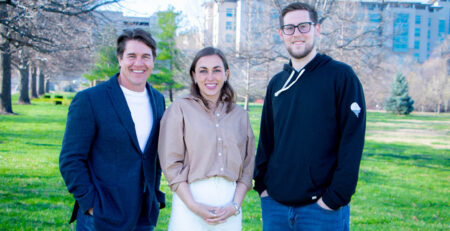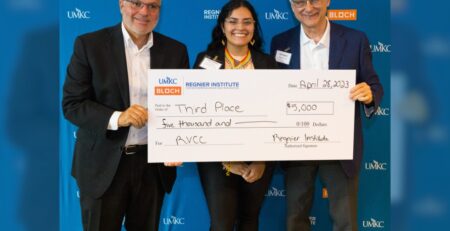Corporate Engagement in Action: Universities Turn on the Faucet of Entrepreneurship so Corporations Can Tap In
This story is part of a series that explores how Kansas City corporations are supporting entrepreneurship and why corporate engagement is important. For more, explore the new We Create Corporate Engagement report.
About a half dozen people pore over computer monitors arranged in two workstation clusters. Others are busy at a separate bench space containing additional equipment and devices. All involved are hard at work on projects for Garmin, a technology company that delivers innovative GPS technology for aviation, marine, fitness, outdoor recreation, tracking and mobile apps.
But the scene isn’t taking place at Garmin’s headquarters in Olathe, Kansas. No, it’s playing out 35 miles away at the Bioscience and Technology Business Center, or BTBC, at the University of Kansas in Lawrence, where Garmin has operated a project lab for engineering and computer science interns for 10 years.
KU’s BTBC demonstrates that corporate-academic alliances can produce beneficial results for universities, companies and students.
“There are assets that reside within universities that I think have largely gone untapped. And private industry is starting to see the benefit in that,” said GR Underwood, president and chief operating officer of the BTBC.
Corporations like Garmin are seeing the advantage of tapping into and developing student talent for the innovative workforces they seek. Corporations are also recognizing the value of strategic relationships with universities and startups to fill the role of early-stage R&D.
“Smaller companies are willing to work on riskier projects that larger companies simply wouldn’t pursue because the cost isn’t worth the potential payoff in terms of shareholder value,” said Underwood. “Additionally, smaller companies often will develop more niche technologies because it might be based upon the highly specific personal expertise or background of the founders. They may have a knowledge base, experience or ideas that simply may not exist in larger companies.”
For their part, universities are beginning to understand that their recruitment efforts—as well as government funding of their research—are enhanced by teaming with the private sector.
“Quite often, universities are willing to buy equipment and instrumentation, outfit highly specialized labs and conduct highly resource intensive research that larger private industry firms are simply unwilling to invest in. But they can contract with universities to use those assets,” said Underwood. “However, often they don’t because I don’t think they’re aware of them.”
Working jointly on EcoDevo
The BTBC was born a dozen years ago when KU, the City of Lawrence, Douglas County and the local business community via the Lawrence Chamber realized that rather than pursue their economic development initiatives independently, they could pool their resources to create, recruit, grow and retain high-tech and life sciences companies in northeastern Kansas.
Currently, 56 companies—ranging from small businesses to large corporations—participate in the program. All are high-tech enterprises focusing on one of five areas: animal health, human health, engineering, software and food/ag tech. The companies residing within the BTBC system (which spans three facilities from the main facility to KU’s West Campus to the University of Kansas Medical Center in Kansas City, Kansas) employ more than 350 employees, resulting in excess of $21 million in annual payroll.
The BTBC provides support to its high-tech tenant companies in three ways: (1) physical space that features customized, state-of-the-art laboratories and office space; (2) business services ranging from business planning and assessment of commercial feasibility to financial modeling, grant management and an internship program; and (3) facilitating relationships with KU researchers, local government officials and local professional service providers.
[[CTA]]
Top-notch student talent
Garmin is not just a pioneer in the GPS industry. It was also one of the first companies to become part of the BTBC.
Taking up residence in 2010, Garmin’s main interest has been tapping KU’s computer science and electrical engineering students for on-campus internships where students have the opportunity to work on aviation and consumer automotive projects that are essential to developing the company’s personal navigation devices.
“When it comes to our remote school offices, we focus on hiring software engineer candidates studying computer science or computer engineering,” said Hanna Bohl, university relations recruiter at Garmin. “We look for students with experience in C, C++ programing that have an interest in Garmin and the products we create as well as being motivated to work hard to grow their skills.”
Interested students complete an application on the Garmin website, as anyone seeking a Garmin internship would do. The students who are selected serve as part-time interns during the school year, working a minimum of 13 hours a week on projects identified by the internal Garmin project team. Generally, new interns work on smaller projects and graduate to larger, more intense work as they learn. Many students become full-time interns at Garmin headquarters during the summer months and then return to part-time status at the BTBC once school resumes in the fall.
Being embedded on campus was a major attraction for Garmin. The BTBC lab solves a logistical problem for students who can’t get to the main Garmin campus but can access the BTBC lab between classes. Although the students are working remotely, they work on actual Garmin projects and perform according to internal Garmin guidelines.
“They are working on real projects that we’re working on at Garmin. They’re just working in a remote way,” said Bohl. “They still are checking in and having meetings with their managers and their mentors. They’re still having those people to connect with.”
A full-time Garmin associate works on the KU campus, overseeing the interns’ work and managing the program office.
Fostering the Garmin culture
With competition fierce for engineering recruits, Garmin recognized the benefits of being on campus, immersed with talented engineering students they could handpick.
Besides becoming familiar with Garmin projects, processes and procedures, interns also become acclimated to the Garmin culture. Those who are eventually hired for full-time positions at headquarters experience a seamless integration into corporate life at Garmin, able to interact and contribute from the first day.
In 2019, Garmin hired 26 top KU engineering students for the internship program. About a third of those students are committed to coming back as full-time Garmin associates in 2020.
Legitimacy and stability
KU benefits from the relationship as well. Underwood said that having a large, highly successful tech company on campus provides stability and legitimacy for the BTBC and brings it closer to the long-term goal of being a research and business park.
“A research and business park isn’t going to be built on the backs of startups alone,” Underwood said. “You’ve got to have large established companies come in and want to play a role as well.”
In addition, the BTBC allows the university to provide students with an expanded, practical learning experience and potential employer after graduation—both of which help in the university’s recruiting efforts.
Creating corporate-university collisions
Bohl said that to create more collisions between companies and universities, companies need to get more creative about ways to get in front of students and create lasting impressions. She noted that to help create awareness, Garmin offered an open house of Garmin’s KU campus office and has a campus ambassador program.
“I think we get a really big return on word-of-mouth, having the students talking about those experiences,” said Bohl. “It’s almost like having our own personal recruiting without me even going on campus. They talk to their friends, they share their experience. We try to make the best internship experience that we possibly can because we know these students are working in the office part time during the school year. So, when these students are going back on campus, they’re talking about the great benefits of Garmin. Having our alumni that help us on campus has helped with that return as well.”
Garmin has extended its reach into the university system with campus offices at Kansas State University in Manhattan, Kansas; Missouri State University in Springfield, Missouri; and Missouri University of Science and Technology in Rolla, Missouri. The company is also eyeing programs that would allow it to develop a presence among students in grades K-12.
Underwood believes that building a space where companies ranging from startups to large corporations can be in the same proximity encourages companies to work together.
“We’ve been fortunate in that we’ve been able to create an environment where these companies are co-located,” he said. “We’re starting to see our companies work together. We’re starting to see them engage one another. But that has taken time. That cross-pollination doesn’t occur unless you can get them in the same room. But having this location here has helped facilitate that.”
He noted that many larger companies simply don’t understand what smaller companies can do for them.
“The big fish want to be around the small fish, so to speak. We’ve actually done a fair amount of research on this in other communities—Boston, San Francisco, Austin. You see large companies moving into those regions because they want access to talent, but they also want access to the smaller startups who are doing early-stage research and creating new technologies that simply aren’t on the bigger companies’ radars. That’s why proximity to smaller firms and the resulting density that occurs is vital. Kansas City has kind of lagged in that regard, but I think a lot of companies are starting to figure it out.”





Leave a Reply